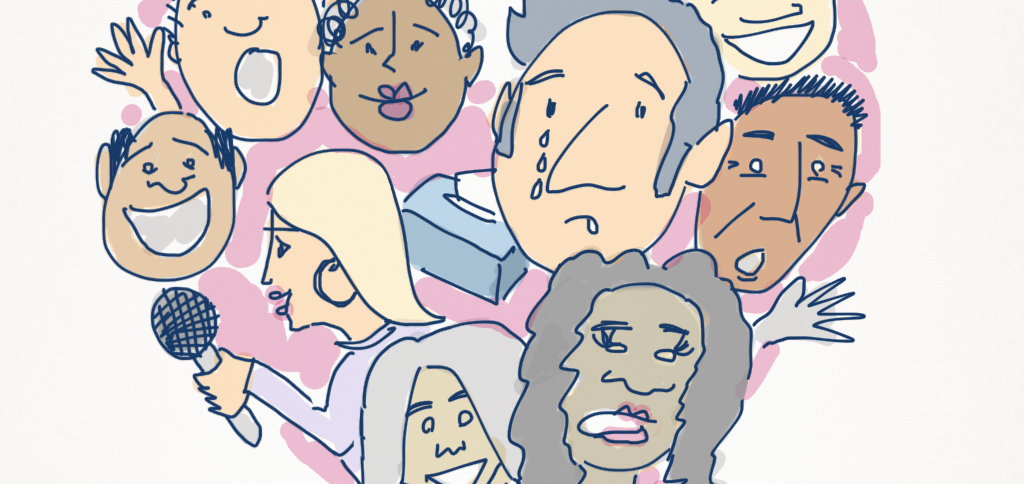In a previous post I wrote that empathy was a core skill for becoming an effective user experience designer.
Several people commented that the concept of empathy as being something you could learn (and therefore be taught) was new to them—surely this is a character trait that you either have, or you don’t?
Not so. As with many of the social sciences, one’s ability to empathise is not absolute, but exists on a spectrum. Of course, there may be individuals who, for whatever reason, are simply unable to experience compassion. This article is not for them. I do believe, however, that most people can develop stronger empathic skills with the right combination of theory, practice, self-awareness and support.
Don’t Just Take My Word For It …
The fact that empathy is a skill that can be taught is well known to parents of children diagnosed with Autistic Spectral Disorder (ASD). The “lack of social or emotional reciprocity” is one of the characteristics that clinicians look for when diagnosing the disorder, and therapy often focusses on specific exercises designed to better understand emotion (and gain empathy as a result). Empathy is important for us to function as humans.
In this post I’ll outline eight techniques that you can use to consciously improve your own empathy. Why bother doing so? Because it will make you a better designer. You’ll have a stronger connection to the users of the system, and this will influence your design decisions.
1. Notice Everyday Pain
Fine-tune your empathy radar to be aware of people experiencing pain in their every day life. It could be someone getting frustrated at trying to lower their deskchair or saying a tearful goodbye to a loved one at the airport. But it needn’t be limited to happenings around you—characters on TV or in books will serve well too.
Pay attention to these situations, and make the effort to imagine how the person (or fictitious character) must be feeling. Fine-tuning your emotional radar like this will mean when it comes time to interacting with the users of your product, your empathy will come more naturally.
2. Be Present
When conducting user interviews, it’s important that you give your full attention. Really be there for your interviewees, and they’ll give you more back. As Miki Kashtan writes:
There is a high correlation between one person’s listening presence and the other person’s sense of not being alone, and this is communicated without words. We can be present with someone whose language we don’t understand, who speaks about circumstances we have never experienced or whose reactions are baffling to us. It’s a soul orientation and intentionality to simply be with another.
3. Shadow Your Users
It depends on the type of product you’re designing, but if possible, I recommend shadowing somebody using it (or performing the tasks that your product will replace). If this is a website or mobile app, you may wish to try this using a family member or friend first. Much like a user testing sessions, give them a task to complete and then watch how well they perform. If appropriate, it can be useful to record audio or video of this interaction. Get permission first!
You can take this concept one step further …
4. Walk A Mile In Their Shoes
If you’re in the early stages of a project and need to understand how someone completes their tasks, have a go at doing them yourself—if it’s appropriate (data entry or booking a rental car may be doable; operating heavy machinery or medical equipment may not be). If possible, this experience will give you even more insights into the challenges your users face than watching someone else use your product. You’ll certainly gain an appreciation for the frustrations faced by a novice user.
5. Find Common Ground
Research into teaching empathy to children reveals that shared experiences and interests can help children develop empathy with that person:
Experiments suggest that kids are more likely to feel empathy for individuals who are familiar and/or similar to them (e.g., Zahn-Waxler et al 1984; Smith 1988). Kids may also find it easier to empathize with people who they’ve shared unpleasant experiences with (Murphy 1937).
So it’s probably helpful to make kids aware of the similarities they may share with other people. The more we can humanize the victims of distress or tragedy, the better kids will be able to respond with empathy.
While there’s no need to actively seek out unpleasant experiences, your user research interviews are going to go a lot smoother if you have a common interest—whether that’s a hobby, a local sporting team, or a TV show that you both like.
8. Make Faces
Studies have shown that going through the motion of making a facial expression can actually result in us experiencing the associated emotion. If you want to increase the degree of empathy you’re feeling for a specific situation, it’s possible that imitating the facial expressions of the person you want to empathise with will help make this happen.
6. Role Play
Stephen P. Anderson recently wrote about the power of role-play when designing interactions. If you’re working with a team, encourage them to talk out loud the user interactions with your existing or hypothetical product. The insights will not only help you write better microcopy, but your empathy for the users of the product will increase as well.
7. Review Research In A Group
In his 2007 book Blink, Malcolm Gladwell discusses a study of patient-physician communication that clearly demonstrated the difference between doctors who are sued for malpractice and doctors who are not. The difference lay in their bedside manner.
I imagine that empathy (or lack of) played a huge part in these patient-physician relationships—General Practitioners (GPs) who participate in Balint groups have long understood the power of empathy in their profession. A Balint group is a discussion groups for medical professionals to confidentially discuss problem patients. The focus is on developing a sense for how the patient must feel, and identifying strategies to address these patient feelings.
Likewise, user research is best shared and discussed, to not only garner new insights but to instil empathy for your users in yourself and others in your team.
8. Find A Mentor
Exposure to role models who exhibit strong empathy for others can motivate you to strive for the same. Whether it’s a formal mentoring arrangement, or just another user experience designer or user researcher who you respect and enjoy catching up regularly for lunch or coffee, make the time to meet regularly and discuss your projects and design challenges. Getting another perspective on your users may help you to understand them better.
Simply being aware of one’s own ability to empathise is a step in the direction of increasing one’s empathy. By following these tips, you should experience an increased connection with your users, resulting in better design decisions and a more satisfying personal life to boot. At least, that’s what the research says.
Do you have any other tips for improving your empathy? Share them in the comments!
Related Reading
- The Center For Building A Culture Of Empathy (cultureofempathy.org)
- The Importance Of Empathy: How To Strengthen Our Ability To Be More Empathic (education.com)
- A Radical Experiment In Empathy: TEDx talk by Sam Richards






Thanks very much Matthew for including a link to my ‘Ethical Nag’ post called “Why Doctors Get Sued” (under your #7 point: ‘a study of patient-physician communication’)
Your eight points here are bang on, but I’d consider adding a ninth one for those interested in enhancing empathy – particularly for designers of things like mobile health apps, for example.
#9 – “Think like a patient!”
When I wrote recently about self-tracking health indicators, one of my readers responded with a unique perspective as both a patient living with a serious illness as well as being a tech-savvy developer. She wrote:
““I speak from the experience of being an acutely sick patient who needed a tool to perform the task of recording my symptoms as requested by my doctor. I assumed there’d be an app for that, but there wasn’t, so I went about making my own. Because I was actively sick at the time, I knew certain things that a healthy person might completely miss – something as simple as not using sliders on a screen because they’re harder to activate (and require more thought) than a button.”
Tech insiders sometimes forget that the real-life end user may not in fact be anything like them (or their family members or friends who are test-driving products for them). They may have significant limitations unique to their diagnosis, age group or health literacy, for example. More on this at: “Does Knowing Change Behaving?” – http://ethicalnag.org/2013/01/13/does-knowing-change-behaving/
While I was attending Stanford’s Medicine X conference last fall, another participant – a physician – Tweeted what I thought summed up beautifully the high-fiving hype of the Silicon Valley health tech startups there.
“Why so many services & apps for the 1%? The users of so many of these products are not the patients I care for”
In other words: “Welcome to our world!”
Thank you so much for these insights, Carolyn!
Matthew
May I suggest a further resource to learn more about empathy and compassion.
The Center for Building a Culture of Empathy
The Culture of Empathy website is the largest internet portal for resources and information about the values of empathy and compassion. It contains articles, conferences, definitions, experts, history, interviews, videos, science and much more about empathy and compassion.
http://CultureOfEmpathy.com
I’d also like to invite you to do an interview with me about empathy and design.. see.
http://bit.ly/y8WS7V
Thanks for your comment Edwin. I did link to the Center in my Related Reading links at the bottom of the post. I’ll be in touch about the interview.